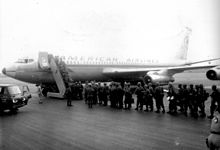American Airlines Flight 1

An American Airlines Boeing 707 similar to the aircraft involved in the accident.
|
|
| Accident summary | |
|---|---|
| Date | March 1, 1962 |
| Summary | Improper maintenance, manufacturing defect leading to mechanical failure |
| Site | Jamaica Bay, Queens, New York, United States |
| Passengers | 87 |
| Crew | 8 |
| Fatalities | 95 (all) |
| Survivors | 0 |
| Aircraft type | Boeing 707-123B Astrojet |
| Operator | American Airlines |
| Registration | N7506A |
| Flight origin | New York International Airport, New York City |
| Destination | Los Angeles International Airport, Los Angeles, California |
American Airlines Flight 1 was a domestic, scheduled passenger flight from New York International (Idlewild) Airport (now John Kennedy International Airport), to Los Angeles International Airport. On March 1, 1962, the plane – having just taken off two minutes earlier – rolled over and crashed into a swamp, killing all 87 passengers and eight crew members aboard. A Civil Aeronautics Board (CAB) investigation determined that a manufacturing defect in the automatic pilot system led to an uncommanded rudder control system input, causing the accident. A number of notable people died in the crash. It was the sixth fatal Boeing 707 crash and, at the time, the deadliest.
The aircraft was a Boeing 707-123B, U.S. Registry N7506A. It was delivered to American Airlines on February 12, 1959. At the time of the crash, it had accumulated 8,147 flight hours. Its last periodic inspection had occurred on January 18, 1962 at 7,922 hours of air time. The flight crew consisted of Captain James Heist, First Officer Michael Barna, Jr., Second Officer Robert Pecor, and Flight Engineer Robert Cain. Also aboard were four stewardesses: Shirley Grabow, Lois Kelly, Betty Moore, and Rosalind Stewart.
The aircraft received instructions to taxi to Runway 31L at 9:54 AM EST, and clearance to proceed to Los Angeles non-stop under instrument flight rules (IFR) at 10:02 AM EST. Flight 1 became airborne at 10:07 AM EST. Following American Airlines procedures and Departure Control instructions, the aircraft initiated a left turn to a heading of 290. In the course of the turn, at 1,600 feet, the Boeing banked too far, flipped past 90 degrees, and began an upside-down, nose-first descent in a nearly vertical dive.
Flight 1 crashed into Pumpkin Patch Channel, Jamaica Bay, at 10:08:49, while angled at 78 degrees and on a magnetic heading of 300 degrees. Passengers aboard a Mohawk Airlines plane bound for Albany that took off immediately after Flight 1 watched the plane plunge into the bay. The jet exploded upon impact, a geyser of brackish water and black smoke erupted from the site, and the scattered debris and fuel caught fire. Long Island residents described hearing explosions which shook the foundations of nearby houses, though no one on the ground is known to have witnessed the plane hitting the swamp. However, a few men at Naval Air Station New York / Floyd Bennett Field saw the massive geyser of water rising above the hangars, and one guard—at his post on a bridge that the plane flew over—saw the plane roll over.
...
Wikipedia
